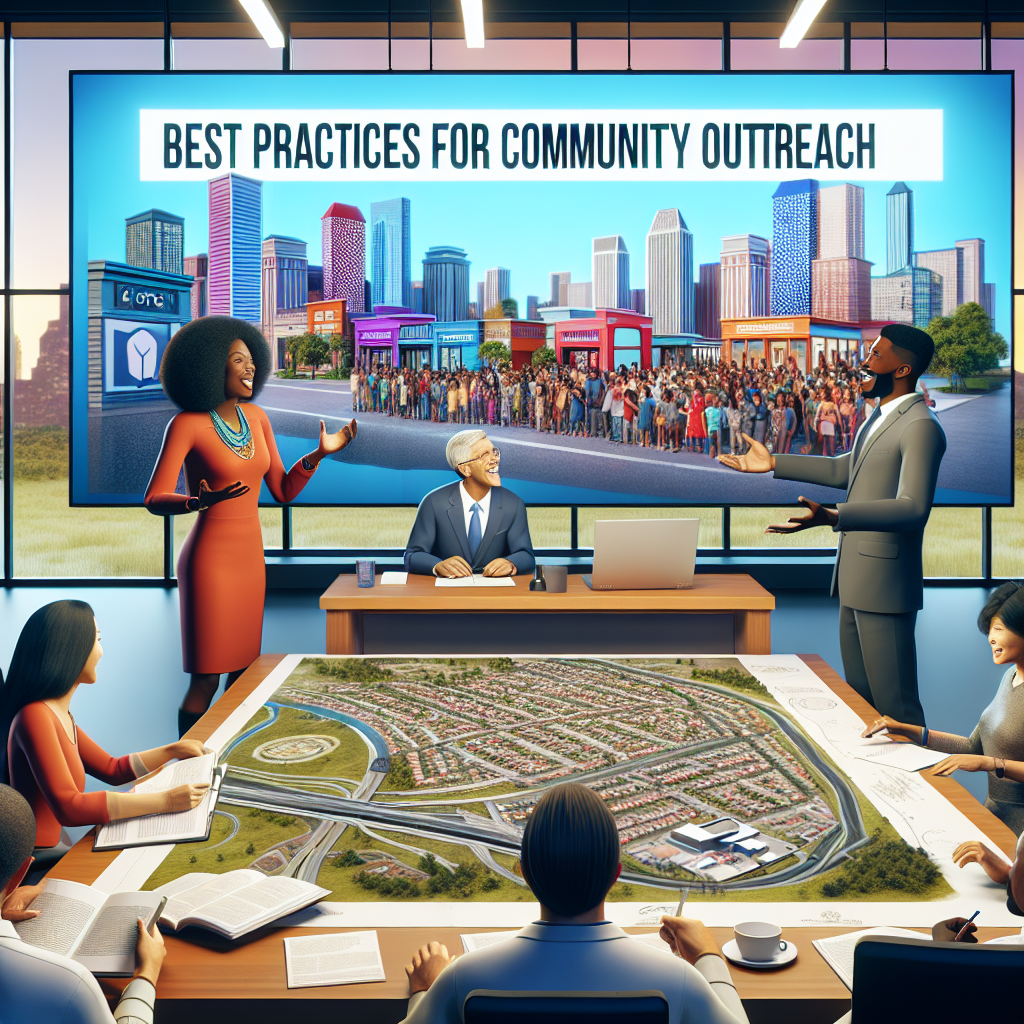Community outreach is a cornerstone of building strong relationships and connections within a community. By engaging with individuals, organizations, and institutions, community outreach can foster a sense of unity and collaboration. In this comprehensive guide, we will delve into the best practices for successful community outreach initiatives. From effective communication strategies to impactful engagement techniques, we will explore how to engage with diverse groups and build meaningful relationships. Whether you are a non-profit organization, business, or individual looking to make a positive impact in your community, this guide will provide you with the tools and knowledge to effectively reach out and connect with those around you.
Understanding Community Outreach

Community outreach is a strategic approach employed by organizations, institutions, and businesses to connect with the local community. It involves actively reaching out to community members, stakeholders, and groups to foster positive relationships, address issues, and collaborate on initiatives that benefit the community as a whole.
-
Defining community outreach:
Community outreach encompasses a range of activities designed to engage with the community, including but not limited to organizing events, conducting surveys, hosting workshops, and partnering with local organizations. It is a proactive effort to establish a meaningful presence within the community and create opportunities for dialogue, interaction, and mutual support. -
Importance of community outreach:
Community outreach plays a crucial role in building trust, promoting inclusivity, and driving positive change within the community. By actively listening to community needs, concerns, and aspirations, organizations can tailor their programs and services to better meet the community’s expectations. This, in turn, leads to increased community support, enhanced reputation, and a stronger sense of belonging among community members. -
Impact of effective community outreach:
When done effectively, community outreach can have a transformative impact on both the organization and the community it serves. It can lead to improved communication, increased civic engagement, and greater social cohesion. Effective community outreach can also help identify emerging issues, mobilize resources, and empower community members to take collective action towards common goals. Ultimately, successful community outreach efforts can contribute to the overall well-being and resilience of the community.
Planning Your Community Outreach Strategy
Setting Clear Objectives
Setting clear objectives is a foundational step in developing a successful community outreach strategy. Without specific goals in place, efforts may lack direction and fail to effectively address the needs of the community. Here are key considerations for setting clear objectives:
-
Defining specific goals: Begin by clearly defining what you aim to achieve through your community outreach efforts. Whether it is increasing awareness about a cause, driving participation in a program, or fostering community engagement, specificity is key. For example, instead of setting a vague goal like “improve community relations,” a specific goal could be “increase volunteer participation by 20% in the upcoming community clean-up event.”
-
Aligning objectives with community needs: It is essential to align your objectives with the actual needs and priorities of the community you are targeting. Conducting thorough research, engaging with community members, and understanding their perspectives can help ensure that your objectives are relevant and meaningful. By addressing real needs, your outreach efforts are more likely to resonate with the community and drive positive impact.
Identifying Target Audience
Planning Your Community Outreach Strategy
In community outreach, identifying the target audience is a crucial initial step to ensure the effectiveness of your efforts. This involves delving into the demographics of the community and conducting thorough research to pinpoint the specific groups that your outreach should focus on.
- Understanding the community demographics
-
Before embarking on any outreach initiatives, it is essential to gain a comprehensive understanding of the demographics of the community you are targeting. This includes factors such as age, gender, income levels, educational background, cultural diversity, and any other relevant data that can help tailor your outreach efforts.
-
Conducting research to pinpoint target groups
- Conducting research is key to identifying the specific target groups within the community that are most in need of your services or support. This research may involve surveys, focus groups, interviews, or data analysis to gather insights into the challenges, needs, and preferences of different segments of the community. By pinpointing these target groups, you can tailor your outreach messages and activities to resonate more effectively with their unique circumstances and interests.
Implementing Effective Communication Channels
Leveraging Social Media Platforms
In today’s digital age, leveraging social media platforms has become a crucial component of successful community outreach strategies. Organizations can effectively connect with their target audience by utilizing platforms such as Facebook, Instagram, and Twitter. These platforms offer a direct line of communication with community members, allowing for real-time interaction and engagement.
Utilizing platforms such as Facebook, Instagram, and Twitter allows organizations to reach a wide range of individuals within the community. Each platform offers unique features that can be tailored to specific outreach goals. For example, Facebook’s group feature can facilitate community discussions and collaboration, while Instagram’s visual nature is ideal for showcasing events and initiatives. Twitter, with its quick and concise format, is great for sharing timely updates and engaging in conversations with community members.
Engaging with the community through interactive posts is key to maintaining a strong online presence. By creating polls, surveys, and contests, organizations can encourage community members to actively participate and voice their opinions. Responding to comments and messages in a timely manner shows that the organization values community feedback and is committed to fostering meaningful connections. Additionally, sharing user-generated content and testimonials can help build trust and credibility within the community.
In conclusion, social media platforms offer a powerful tool for organizations to enhance their community outreach efforts. By strategically leveraging these platforms and fostering two-way communication, organizations can effectively engage with community members, raise awareness about their initiatives, and ultimately build a stronger and more connected community.
Establishing Partnerships
Establishing partnerships is a crucial aspect of successful community outreach efforts. By collaborating with local organizations and businesses, community initiatives can leverage existing networks and resources to amplify their impact. Here are some key strategies for forging effective partnerships:
-
Identifying Potential Partners: Begin by researching organizations and businesses in the community that share similar goals or values. Look for entities that complement your outreach efforts and have a vested interest in the well-being of the community.
-
Building Trust and Rapport: Establishing trust is essential in any partnership. Take the time to meet with potential partners, communicate openly about goals and expectations, and ensure that all parties are committed to the shared vision.
-
Defining Roles and Responsibilities: Clearly outline the roles and responsibilities of each partner to avoid misunderstandings or conflicts down the line. Develop a formal agreement that delineates expectations, contributions, and outcomes.
-
Collaborating on Joint Initiatives: To maximize impact, consider hosting joint events or projects that bring together the strengths and resources of all partners. This can help reach a wider audience and demonstrate a unified front in supporting the community.
-
Maintaining Ongoing Communication: Regular communication is key to sustaining partnerships over time. Schedule check-ins, share progress updates, and address any challenges or concerns proactively to ensure the partnership remains strong and effective.
By following these best practices for establishing partnerships in community outreach efforts, organizations can foster collaborative relationships that drive meaningful change and create lasting positive impact in the community.

Organizing Engaging Events and Activities
Hosting Workshops and Seminars
When it comes to community outreach, hosting workshops and seminars can be an effective way to engage with the local population and provide valuable educational opportunities. These events allow for in-depth discussions and interactions on specific topics, fostering a sense of community collaboration and learning. Here are some key points to consider when organizing workshops and seminars for community outreach:
-
Identify Relevant Topics: It is crucial to select topics that are of interest and relevance to the community. Conducting surveys or consulting with community leaders can help determine the most pressing issues or areas where education is needed.
-
Invite Knowledgeable Speakers: To ensure the success of workshops and seminars, it is important to invite speakers who are knowledgeable and experienced in the chosen topic. Expertise and credibility can help in delivering valuable insights and information to the attendees.
-
Provide Interactive Sessions: Incorporating interactive elements such as Q&A sessions, group discussions, and hands-on activities can enhance engagement and participation. This allows attendees to actively participate in the learning process and share their perspectives.
-
Promote Inclusivity: Make sure that workshops and seminars are accessible to all members of the community by considering factors such as location, timing, and language. Providing translations or accommodations for individuals with disabilities can help in creating an inclusive environment.
-
Encourage Networking: Apart from the educational aspect, workshops and seminars also serve as networking opportunities for community members. Facilitate networking sessions or breaks where attendees can connect with each other, exchange ideas, and build relationships.
By following these best practices, hosting workshops and seminars can be a powerful tool for community outreach, fostering knowledge sharing, collaboration, and engagement among local residents.
Conducting Volunteer Programs
Volunteer programs can be a powerful tool for community outreach, providing opportunities for community members to actively participate in initiatives that benefit the collective welfare. By involving individuals in meaningful projects, organizations can tap into a diverse range of skills and resources that contribute to the success of the program. Engaging volunteers in tasks that align with their interests and expertise not only enhances the quality of the outcomes but also fosters a sense of personal fulfillment and accomplishment.

Furthermore, volunteer programs play a crucial role in fostering a sense of unity and teamwork within the community. When individuals come together to work towards a common goal, it creates a shared purpose that transcends individual differences and promotes collaboration. Through collaborative efforts, community members can build strong relationships, enhance social cohesion, and develop a deeper sense of belonging and ownership towards the community initiatives. Encouraging teamwork and cooperation among volunteers can lead to the establishment of a supportive network that extends beyond the duration of the program, creating a lasting impact on community cohesion and solidarity.
Measuring Success and Building Long-Term Relationships
Tracking Metrics and Evaluating Impact
In the realm of community outreach, tracking metrics and evaluating impact are crucial components for assessing the effectiveness of initiatives and ensuring that resources are allocated efficiently. By implementing a robust system for monitoring and evaluation, organizations can gain valuable insights into the reach and resonance of their outreach efforts, ultimately facilitating informed decision-making and continuous improvement.
Monitoring Outreach Efforts Through Data Analysis
Utilizing Data Collection Tools: Organizations can employ various data collection tools such as surveys, interviews, focus groups, and social media analytics to gather quantitative and qualitative information about their community outreach activities. By systematically collecting data at different touchpoints, it becomes possible to paint a comprehensive picture of the impact of these initiatives.
Establishing Key Performance Indicators (KPIs): Defining clear KPIs aligned with the goals of the outreach program is essential for tracking progress and measuring success. These indicators should be specific, measurable, achievable, relevant, and time-bound (SMART), allowing organizations to quantitatively assess their performance against predetermined benchmarks.
Analyzing Data Trends: Through the systematic analysis of collected data, organizations can identify trends, patterns, and correlations that offer valuable insights into the effectiveness of their community outreach efforts. By examining metrics such as engagement levels, reach, conversion rates, and feedback sentiments, organizations can pinpoint areas of strength and opportunities for enhancement.
Adapting Strategies Based on Performance Indicators
Continuous Improvement: The process of tracking metrics and evaluating impact should not be viewed as a one-time exercise but rather as an iterative cycle of continuous improvement. By regularly reviewing performance indicators and analyzing data trends, organizations can identify areas that require adjustment or enhancement to optimize the impact of their community outreach initiatives.
Flexibility and Adaptability: In response to the insights gleaned from data analysis, organizations should demonstrate flexibility and adaptability in refining their outreach strategies. This may involve reallocating resources, revising messaging approaches, targeting new audience segments, or exploring innovative engagement channels to better align with the evolving needs and preferences of the community.
Feedback Loop: Establishing a feedback loop that incorporates insights from stakeholders, community members, and partners is essential for refining outreach strategies based on real-time feedback. By soliciting input, listening attentively to suggestions, and incorporating constructive criticism, organizations can ensure that their community outreach efforts remain relevant, impactful, and responsive to the diverse needs of the communities they serve.
Cultivating Sustainable Connections
Building long-term relationships within the community is a foundational aspect of successful outreach efforts. To cultivate sustainable connections, organizations must go beyond one-time interactions and strive to create meaningful engagement opportunities that foster trust and collaboration. Here are key strategies for cultivating sustainable connections:
-
Consistent Engagement: Regularly engage with community members through various channels such as community events, workshops, and social media platforms. Consistency in communication helps maintain relationships and demonstrates a commitment to ongoing dialogue.
-
Personalized Approaches: Tailor outreach efforts to the specific needs and preferences of different community segments. By understanding the unique characteristics of each group within the community, organizations can create more personalized and impactful interactions.
-
Empowerment and Participation: Empower community members to take an active role in decision-making processes and project initiatives. By involving the community in planning and implementation, organizations can foster a sense of ownership and collaboration that strengthens relationships over time.
-
Transparent Communication: Establish transparent communication channels to keep the community informed about outreach activities, progress, and outcomes. Transparency builds credibility and trust, essential elements for maintaining sustainable connections.
-
Long-Term Vision: Develop a long-term vision for community engagement that goes beyond immediate goals. By articulating a clear vision for how outreach efforts will evolve and contribute to the community’s well-being, organizations can inspire long-lasting partnerships and engagement.
-
Feedback Mechanisms: Implement feedback mechanisms that allow community members to provide input, suggestions, and critiques. Actively seeking and incorporating feedback demonstrates a willingness to listen and adapt, reinforcing the value placed on community perspectives.
FAQs for Exploring the Best Practices for Community Outreach: A Comprehensive Guide
What are some key best practices for successful community outreach?
Successful community outreach involves creating genuine connections with community members, understanding their needs, and actively engaging with them on a regular basis. It is important to listen to the community’s input, involve them in decision-making processes, and show a commitment to long-term relationships. Building trust, being transparent, and providing valuable resources and opportunities are all key components of effective community outreach.
How can organizations effectively engage with diverse communities during outreach efforts?
To effectively engage with diverse communities during outreach efforts, organizations should prioritize inclusivity, representation, and cultural competence. It is essential to understand the unique backgrounds, values, and needs of different communities, and tailor outreach strategies accordingly. Building relationships with community leaders and organizations, utilizing diverse communication channels, and creating culturally sensitive programs and materials are all effective ways to engage with diverse communities.
What tools and resources can organizations utilize to enhance their community outreach efforts?
Organizations can utilize a variety of tools and resources to enhance their community outreach efforts, including social media platforms, community forums, email newsletters, and traditional outreach methods such as flyers and posters. Collaborating with local media outlets, hosting community events and workshops, and partnering with other community organizations can also help organizations reach a wider audience and increase their impact. Additionally, utilizing data and evaluation tools to measure the effectiveness of outreach efforts can help organizations identify areas for improvement and make informed decisions moving forward.